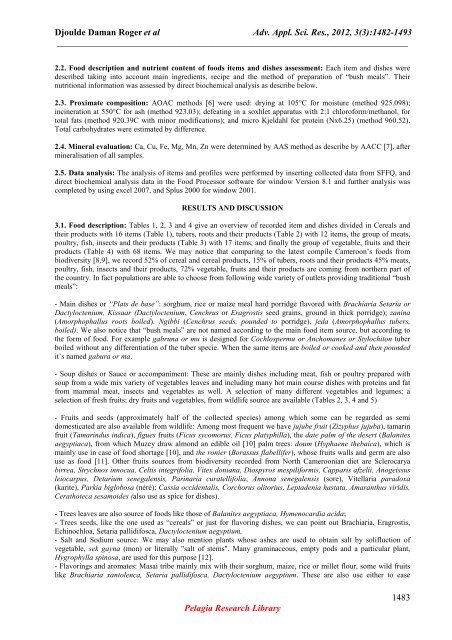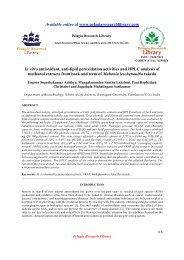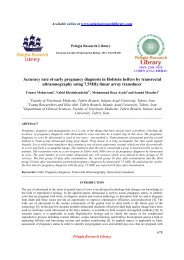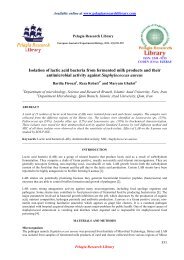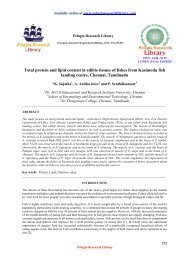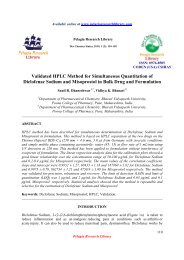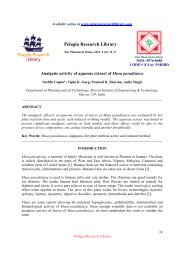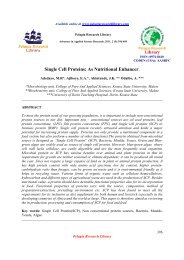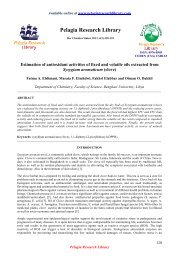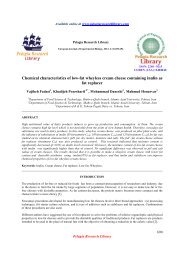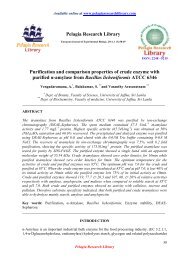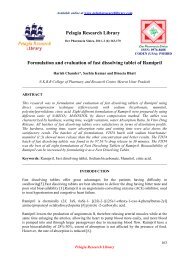Nutritional properties of “Bush Meals” - Pelagia Research Library
Nutritional properties of “Bush Meals” - Pelagia Research Library
Nutritional properties of “Bush Meals” - Pelagia Research Library
Create successful ePaper yourself
Turn your PDF publications into a flip-book with our unique Google optimized e-Paper software.
Djoulde Daman Roger et al Adv. Appl. Sci. Res., 2012, 3(3):1482-1493<br />
_____________________________________________________________________________<br />
2.2. Food description and nutrient content <strong>of</strong> foods items and dishes assessment: Each item and dishes were<br />
described taking into account main ingredients, recipe and the method <strong>of</strong> preparation <strong>of</strong> “bush meals”. Their<br />
nutritional information was assessed by direct biochemical analysis as describe below.<br />
2.3. Proximate composition: AOAC methods [6] were used: drying at 105°C for moisture (method 925.098);<br />
incineration at 550°C for ash (method 923.03); defeating in a soxhlet apparatus with 2:1 chlor<strong>of</strong>orm/methanol, for<br />
total fats (method 920.39C with minor modifications); and micro Kjeldahl for protein (Nx6.25) (method 960.52).<br />
Total carbohydrates were estimated by difference.<br />
2.4. Mineral evaluation: Ca, Cu, Fe, Mg, Mn, Zn were determined by AAS method as describe by AACC [7], after<br />
mineralisation <strong>of</strong> all samples.<br />
2.5. Data analysis: The analysis <strong>of</strong> items and pr<strong>of</strong>iles were performed by inserting collected data from SFFQ, and<br />
direct biochemical analysis data in the Food Processor s<strong>of</strong>tware for window Version 8.1 and further analysis was<br />
completed by using excel 2007, and Splus 2000 for window 2001.<br />
RESULTS AND DISCUSSION<br />
3.1. Food description: Tables 1, 2, 3 and 4 give an overview <strong>of</strong> recorded item and dishes divided in Cereals and<br />
their products with 16 items (Table 1), tubers, roots and their products (Table 2) with 12 items, the group <strong>of</strong> meats,<br />
poultry, fish, insects and their products (Table 3) with 17 items, and finally the group <strong>of</strong> vegetable, fruits and their<br />
products (Table 4) with 68 items. We may notice that comparing to the latest compile Cameroon’s foods from<br />
biodiversity [8,9], we record 52% <strong>of</strong> cereal and cereal products, 15% <strong>of</strong> tubers, roots and their products 45% meats,<br />
poultry, fish, insects and their products, 72% vegetable, fruits and their products are coming from northern part <strong>of</strong><br />
the country. In fact populations are able to choose from following wide variety <strong>of</strong> outlets providing traditional “bush<br />
meals”:<br />
- Main dishes or “Plats de base”: sorghum, rice or maize meal hard porridge flavored with Brachiaria Setaria or<br />
Dactyloctenium, Kissaar (Dactyloctenium, Cenchrus or Eragrostis seed grains, ground in thick porridge); zanina<br />
(Amorphophallus roots boiled). Ngibbi (Cenchrus seeds, pounded to porridge), jeda (Amorphophallus tubers,<br />
boiled). We also notice that “bush meals” are not named according to the main food item source, but according to<br />
the form <strong>of</strong> food. For example gabruna or mu is designed for Cochlospermu or Anchomanes or Stylochiton tuber<br />
boiled without any differentiation <strong>of</strong> the tuber specie. When the same items are boiled or cooked and then pounded<br />
it’s named gabura or ma.<br />
- Soup dishes or Sauce or accompaniment: These are mainly dishes including meat, fish or poultry prepared with<br />
soup from a wide mix variety <strong>of</strong> vegetables leaves and including many hot main course dishes with proteins and fat<br />
from mammal meat, insects and vegetables as well. A selection <strong>of</strong> many different vegetables and legumes; a<br />
selection <strong>of</strong> fresh fruits; dry fruits and vegetables, from wildlife source are available (Tables 2, 3, 4 and 5)<br />
- Fruits and seeds (approximately half <strong>of</strong> the collected species) among which some can be regarded as semi<br />
domesticated are also available from wildlife: Among most frequent we have jujube fruit (Zizyphus jujuba), tamarin<br />
fruit (Tamarindus indica), figues fruits (Ficus sycomorus, Ficus platyphilla), the date palm <strong>of</strong> the desert (Balanites<br />
aegyptiaca), from which Muzey draw almond an edible oil [10] palm trees: doum (Hyphaene thebaica), which is<br />
mainly use in case <strong>of</strong> food shortage [10], and the ronier (Borassus flabellifer), whose fruits walls and germ are also<br />
use as food [11]. Other fruits sources from biodiversity recorded from North Cameroonian diet are Sclerocarya<br />
birrea, Strychnos innocua, Celtis integrifolia, Vitex doniana, Diospyros mespiliformis, Capparis afzelii, Anogeissus<br />
leiocarpus, Detarium senegalensis, Parinaria curatellifolia, Annona senegalensis (sore), Vitellaria paradoxa<br />
(karite), Parkia biglobosa (néré); Cassia occidentalis, Corchorus olitorius, Leptadenia hastata, Amaranthus viridis,<br />
Cerathoteca sesamoides (also use as spice for dishes).<br />
- Trees leaves are also source <strong>of</strong> foods like those <strong>of</strong> Balanites aegyptiaca, Hymenocardia acida;<br />
- Trees seeds, like the one used as “cereals” or just for flavoring dishes, we can point out Brachiaria, Eragrostis,<br />
Echinochloa, Setaria pallidifosca, Dactyloctenium aegyptium,<br />
- Salt and Sodium source: We may also mention plants whose ashes are used to obtain salt by solifluction <strong>of</strong><br />
vegetable, sek gayna (mon) or literally "salt <strong>of</strong> stems". Many graminaceous, empty pods and a particular plant,<br />
Hygrophylla spinosa, are used for this purpose [12].<br />
- Flavorings and aromates: Masai tribe mainly mix with their sorghum, maize, rice or millet flour, some wild fruits<br />
like Brachiaria xantolenca, Setaria pallidifosca, Dactyloctenium aegyptium. These are also use either to ease<br />
<strong>Pelagia</strong> <strong>Research</strong> <strong>Library</strong><br />
1483


